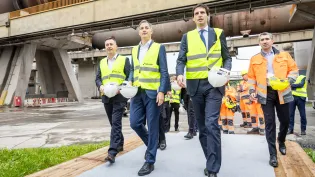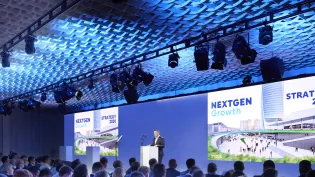Embedding sustainable architecture: Q&A with Henning Larsen’s Kritika Kharbanda
Actors across the construction value chain contribute to sustainability in unique ways. Architects, tasked with designing the built environment, have the unique opportunity to integrate sustainable, circular materials into the earliest stages of a project.
Henning Larsen, established in 1959, has evolved from a Scandinavian architecture company into a global leader in design.
We sat down with Kritika Kharbanda, Henning Larsen’s Global Head of Sustainability, to speak about the exciting potential of sustainable architectural practices, as well as the importance of acting today to shape tomorrow.
What is Henning Larsen’s mission and how do you integrate sustainability?
At Henning Larsen, we are guided by curiosity in everything we do. We ensure our projects create a positive impact for people, societies and communities, today and tomorrow. This philosophy and open mindset have transformed our company from its origins in mid-century Scandinavia into the industry leader we are today.
Yet it is also true that we operate in a very traditional segment of the value chain. Many architects today still rely on techniques like masonry for building walls. These methods offer high artistry and quality but are costly in terms of time and resources. This means we have a wealth of experience and knowledge to draw from, as well as ample room for innovation.
This is why the research our studio is doing into sustainable materials and methods is so important. With each project we undertake, we develop more knowledge that can then be brought to bear on projects at scale.
Why do architects have such a major role to play in creating more sustainable structures?
The carbon that goes into structural materials like cement, what we call embodied carbon, is a key factor in a building’s overall environmental footprint. Over the next two decades, we know that a tremendous amount of construction will take place, making it even more essential to research and incorporate sustainable materials.
We as architects can have a major impact on the environmental footprints of the projects we develop, because the design stage is where the greatest sustainability opportunity lies. When working on new buildings, clients and architects should work closely with sustainability experts from day one.
However, it is not only new buildings where we need to partner with sustainability experts. Architects also contribute to retrofit and renovation projects, during which the building’s entire operations, like energy and water use, can be made greener through material selection.
In sum, architects and sustainability experts are ideally situated to accelerate the adoption of sustainable materials by putting our heads together.

Kritika Kharbanda, Global Head of Sustainability, Henning Larsen
How can we accelerate decarbonization and circularity to meet vital targets and regulations?
We need all hands on deck to effect a widescale transformation of our industry and our world. We should avoid staying in our own bubbles by coming together to share knowledge. Education is of the utmost importance, as it will be the strong foundation for the rest of our sustainability efforts. This is why the Holcim Sustainable Construction Academy is such a valuable program.
The Academy is helping architects, engineers, designers, developers and other changemakers develop the sustainability mindset we need. To truly decarbonize, every stakeholder must prioritize sustainability from the inception of a project.
This is not to say that every contributor has to be an expert in the technical aspects of sustainable solutions. Rather, everyone should understand sustainability at a baseline level, so they can evaluate and select the best solutions for a given project. I am proud to help this effort by presenting examples from Henning Larsen’s sustainable projects in the U.S. and Europe at the Holcim Sustainable Construction Academy.
We also need to change how we work to prioritize this new, sustainability-first outlook. We need materials solutions providers to advise us on the types of green technologies and services available for building projects. Specialists like Holcim, who are breaking new ground and creating novel materials, are in an ideal position to help us adopt innovative solutions early on. Building their technologies into our project specifications will empower us to create truly sustainable buildings.
Interview with Kritika Kharbanda, Global Head of Sustainability, Henning Larsen






























